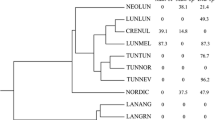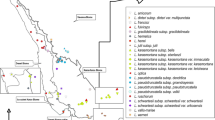Abstract
The genusWolffia was surveyed electrophoretically at 14 allozyme loci. A total of 133 clones representing 10 of the 11 recognized species was examined. Genetic identities among most pairs of species are zero, with non-zero values ranging from 0.14 to 0.40.Wolffia angusta and the newly describedW. neglecta show the highest similarity, and the former species has an identity of 0.14 withW. australiana. The next highest similarity (0.34) occurs betweenW. globosa of Southeast Asia andW. cylindracea of southern Africa, which until recently, had generally been viewed as members of the same species. Other species showing some common alleles are members of a complex involvingW. arrhiza, W. columbiana, W. cylindracea, andW. globosa. WithinW. arrhiza, plants from South Africa and Europe are easily distinguished electrophoretically because each contains unique alleles at two loci. Strains from other parts of Africa vary at these loci and are not totally distinct from either the plants from South Africa or from Europe. Species ofWolffia are much more divergent at allozyme loci than the majority of congeners of flowering plants. This suggests that the species are quite old and that the difficulties in distinguishing taxa morphologically are the result of reduction rather than lack of divergence due to recent speciation. Because of the lack of shared alleles between the majority of species pairs inWolffia, enzyme electrophoresis provides limited resolution of species relationships in the genus.
Similar content being viewed by others
References
Crawford, D. J., 1983: Phylogenetic and systematic inferences from electrophoretic studies. — InTanksley, S. D., Orton, T. J., (Eds): Isozymes in plant genetics and breeding,A. pp. 257–287. — Amsterdam: Elsevier.
, 1989: Enzyme electrophoresis and plant systematics. — InSoltis, D. E., Soltis, P. S., (Eds): Isozymes in plant biology, pp. 146–164. — Portland: Dioscorides Press.
, 1993: Allozyme studies inSpirodela (Lemnaceae): variation among conspecific clones and divergence among the species. — Syst. Bot.18: 389–394.
, 1987: Allozyme divergence and the evolution ofDendroseris (Compositae: Lactuceae) on the Juan Fernandez Islands. — Syst. Bot.12: 435–443.
Den Hartog, C., Van der Plas, F., 1972: The Australian species ofWolffia (Lemnaceae). — Blumea20: 151–153.
Gottlieb, L. D., 1977: Electrophoretic evidence and plant systematics. — Ann. Missouri Bot. Gard.64: 161–180.
, 1981: Gene number of species ofAstereae that have different chromosome number. — Proc. Natl. Acad. Sci. USA78: 3726–3729.
, 1982: Conservation and duplication of isozymes in plants. — Science216: 373–380.
Landolt, E., 1986: The family ofLemnaceae — a monographic study. 1. — Veröff. Geobot. Inst. ETH, Stiftung Rübel (Zürich)71: 1–566.
, 1994: Taxonomy and ecology of sectionWolffia of the genusWolffia. — Veröff. Geobot. Inst. ETH, Stiftung Rübel (Zürich)60: 137–151.
, 1980: List of the studiedLemnaceae samples: origin and chromosome numbers. — Veröff. Geobot. Inst. ETH, Stiftung Rübel (Zürich)70: 205–247.
Les, D. H., 1991: Genetic diversity in the monoecious hydrophileCeratophyllum. — Amer. J. Bot.78: 1070–1082.
Liston, A. A., Rieseberg, L. H., Elias, T. S., 1989: Morphological stasis and molecular divergence in the intercontinental disjunct genusDatisca (Datiscaceae). — Aliso12: 525–542.
Nei, M., 1972: Genetic distance between populations. — Amer. Naturalist106: 283–293.
Triest, L., 1991: Enzyme polymorphism and its relationships to biological features in aquatic plants (including a comparison with terrestrial plants). — InTriest, L., (Ed.): Isozymes in water plants, pp. 201–204. — Opera Bot. Belg.4.
Urbanska-Worytkiewicz, K., 1980: Cytological variation within the family ofLemnaceae. — Veröff. Geobot. Inst. ETH, Stiftung Rübel (Zürich)70: 30–101.
Vasseur, L., Aarssen, L. W., Bennett, T., 1993: Allozymic variation in local apomictic populations ofLemna minor (Lemnaceae). — Amer. J. Bot.80: 974–979.
Weeden, N. F., Wendel, J. F., 1989: Genetics of plant isozymes. — InSoltis, D. E., Soltis, P. S., (Eds): Isozymes in plant biology, pp. 46–72. — Portland: Dioscorides Press.
Wendel, J. F., Weeden, N. F., 1989: Visualization and interpretation of plant isozymes. — InSoltis, D. E., Soltis, P. S., (Eds): Isozymes in plant biology, pp. 5–45. — Portland: Dioscorides Press.
Author information
Authors and Affiliations
Rights and permissions
About this article
Cite this article
Crawford, D.J., Landolt, E. Allozyme divergence among species ofWolffia (Lemnaceae) . Pl Syst Evol 197, 59–69 (1995). https://doi.org/10.1007/BF00984632
Received:
Revised:
Accepted:
Issue Date:
DOI: https://doi.org/10.1007/BF00984632




